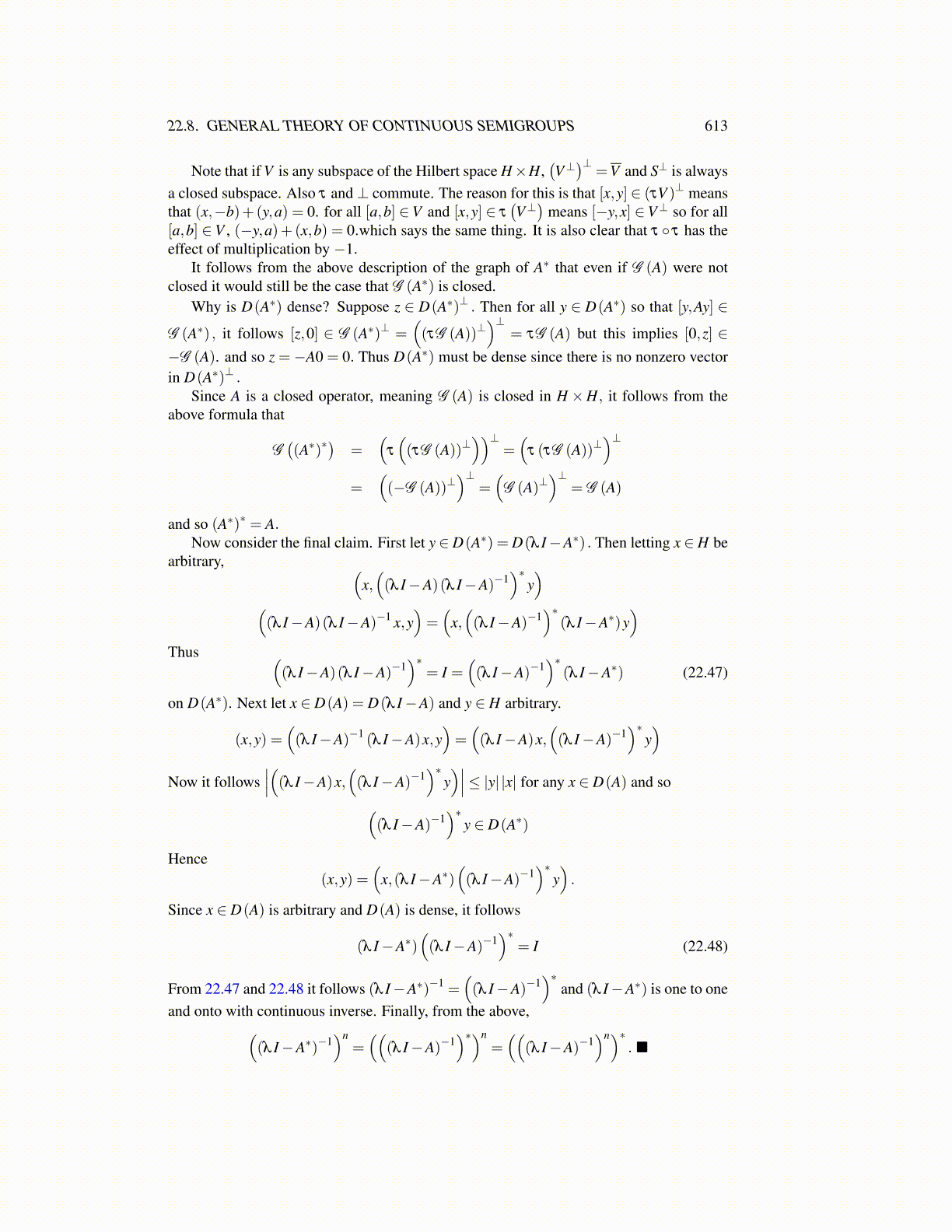
22.8. GENERAL THEORY OF CONTINUOUS SEMIGROUPS 613
Note that if V is any subspace of the Hilbert space H×H,(V⊥)⊥
=V and S⊥ is alwaysa closed subspace. Also τ and ⊥ commute. The reason for this is that [x,y] ∈ (τV )⊥ meansthat (x,−b)+(y,a) = 0. for all [a,b] ∈V and [x,y] ∈ τ
(V⊥)
means [−y,x] ∈V⊥ so for all[a,b] ∈V , (−y,a)+ (x,b) = 0.which says the same thing. It is also clear that τ ◦ τ has theeffect of multiplication by −1.
It follows from the above description of the graph of A∗ that even if G (A) were notclosed it would still be the case that G (A∗) is closed.
Why is D(A∗) dense? Suppose z ∈ D(A∗)⊥ . Then for all y ∈ D(A∗) so that [y,Ay] ∈
G (A∗) , it follows [z,0] ∈ G (A∗)⊥ =((τG (A))⊥
)⊥= τG (A) but this implies [0,z] ∈
−G (A). and so z =−A0 = 0. Thus D(A∗) must be dense since there is no nonzero vectorin D(A∗)⊥ .
Since A is a closed operator, meaning G (A) is closed in H ×H, it follows from theabove formula that
G((A∗)∗
)=
(τ
((τG (A))⊥
))⊥=(
τ (τG (A))⊥)⊥
=((−G (A))⊥
)⊥=(G (A)⊥
)⊥= G (A)
and so (A∗)∗ = A.Now consider the final claim. First let y ∈D(A∗) = D(λ I−A∗) . Then letting x ∈H be
arbitrary, (x,((λ I−A)(λ I−A)−1
)∗y)
((λ I−A)(λ I−A)−1 x,y
)=(
x,((λ I−A)−1
)∗(λ I−A∗)y
)Thus (
(λ I−A)(λ I−A)−1)∗
= I =((λ I−A)−1
)∗(λ I−A∗) (22.47)
on D(A∗). Next let x ∈ D(A) = D(λ I−A) and y ∈ H arbitrary.
(x,y) =((λ I−A)−1 (λ I−A)x,y
)=((λ I−A)x,
((λ I−A)−1
)∗y)
Now it follows∣∣∣((λ I−A)x,
((λ I−A)−1
)∗y)∣∣∣≤ |y| |x| for any x ∈ D(A) and so(
(λ I−A)−1)∗
y ∈ D(A∗)
Hence(x,y) =
(x,(λ I−A∗)
((λ I−A)−1
)∗y).
Since x ∈ D(A) is arbitrary and D(A) is dense, it follows
(λ I−A∗)((λ I−A)−1
)∗= I (22.48)
From 22.47 and 22.48 it follows (λ I−A∗)−1 =((λ I−A)−1
)∗and (λ I−A∗) is one to one
and onto with continuous inverse. Finally, from the above,((λ I−A∗)−1
)n=((
(λ I−A)−1)∗)n
=((
(λ I−A)−1)n)∗
. ■